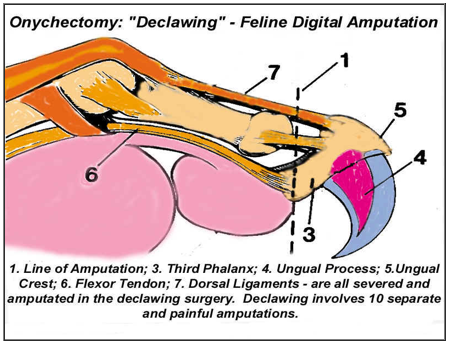Declawing
WE DO NOT ALLOW OUR SPHYNX KITTENS TO BE DECLAWED
PLEASE EDUCATE YOURSELF ON AMPUTATION AND HOW INHUMANE IT IS
THE FACTS ABOUT DECLAWING
(Feline Digital Amputation - "ONYCHECTOMY")
WHAT YOU REALLY NEED TO KNOW

Cats are digitigrades which means they walk on their toes. Their muscles, tendons, nerves, paw, leg joints, shoulder, and back are designed to support and distribute the cat’s weight across their toes as it walks, runs and climbs. Their claws are for balance, exercising, and stretching muscles in their legs, shoulders, and back. They exercise by putting their claws into a surface and pulling back. This is the only way a cat can exercise his muscles. Declawing drastically alters their feet and causes them to meet the ground at an unnatural angle.
Before you declaw, you must first understand what “declawing” is. It is NOT just removing the claw or the “nail.” The cat’s claw is not like a human fingernail. The cat’s claw is the last bone (distal phalanx) in the cat’s toe. Declawing consists of actually amputating not just the claw, but the whole phalanx (toe) up to the joint, including bones, ligaments, and tendons! To remove the claw, the bone, nerve, joint capsule and collateral ligaments and the extensor and flexor tendons must all be amputated. This is not a simple procedure but 10 separate, very painful amputations. If a person had this done each finger would be removed at the last joint.
Some cats go through the declawing process and come out okay. Others suffer psychological and behavioral changes. Cats that were friendly become withdrawn, some become nervous and fearful, and some become aggressive, often resorting to their only remaining means of defense, their teeth. Some cats have an aversion to the litter box due to association with it and pain after surgery. One reason cats scratch is to leave their scent. Declawed cats can no longer mark with their claws, so they mark with urine instead, resulting in inappropriate elimination problems.
A cat depends on its claws as its primary means of defense. Removing them makes the cat feel defenseless.
Excerpted from The Cat Who Cried For Help
By Dr. Nicholas Dodman, Professor of Behavioral Pharmacology and Director of the Behavior Clinic at Tufts University School of Veterinary Medicine.
“The inhumanity of the procedure is clearly demonstrated by the nature of cats’ recovery from anesthesia following the surgery. Unlike routine recoveries, including the recovery from neutering surgeries, which are fairly peaceful, declawing surgery results in cats bouncing off the walls of the recovery cage because of excruciating pain.
Cats that are more stoic huddle in the corner of the recovery cage, immobilized in a state of helplessness, presumably by overwhelming pain. Declawing fits the dictionary definition of mutilation to a tee. Words such as deform, disfigure, disjoint, and dismember all apply to this surgery. Partial digital amputation is so horrible that it has been employed for torture of prisoners of war, and in veterinary medicine, the clinical procedure serves as a model of severe pain for testing the efficacy of analgesic drugs. Even though analgesic drugs can be used postoperatively, they rarely are, and their effects are incomplete and transient anyway, so sooner or later the pain will emerge.”
Cats simply like to scratch; they were created this way for a reason.
Declawing robs a cat of an integral means of movement and defense. Some cats recover from this horrible experience; some do not. They are your family member, and they trust you to do what is best for them, not alter and change them to fit your lifestyle. DON’T BETRAY THAT TRUST!
| Contact us in San Marcos, California, to see which of our hairless cats is the perfect match for your family. |
|
|
|